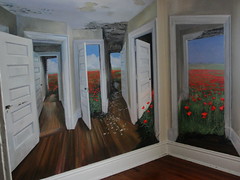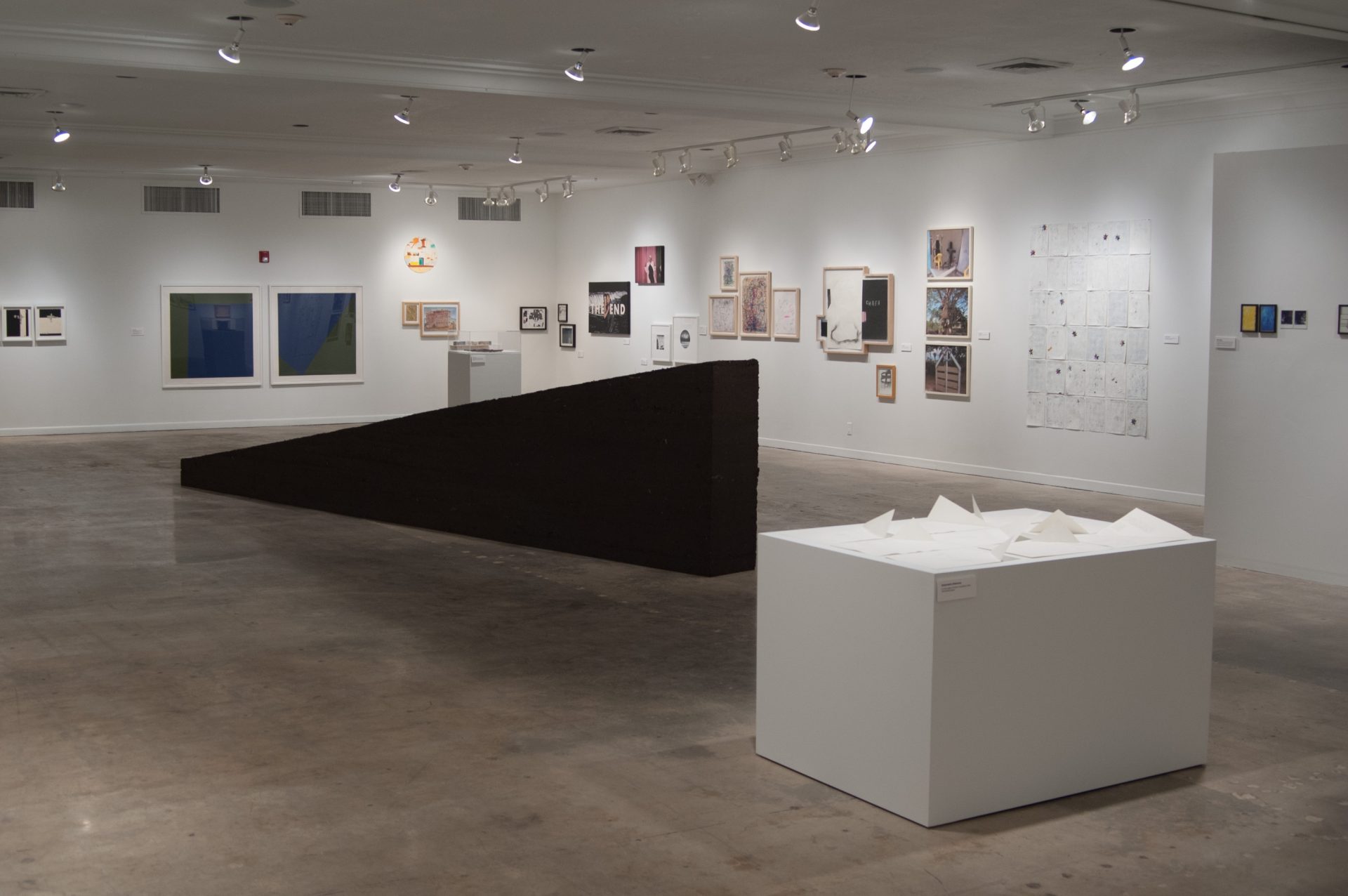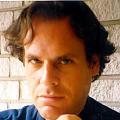No Longer Empty presents The Sixth Borough
Governors Island, NYC
June 5 – October 10, 2010

June 7, 2010. No Longer Empty: non-profit arts organization, collective of curators, administrators, artists. Product of the recession, response to the downturn, creates new curatorial structures to accommodate new economic realities. Has been placing art in public spaces for a year. Eight projects thus far. Takes advantage of commercial spaces throughout city that are empty due to the economic slowdown, “liberating” them for art projects. Not squats. Rather: diverse spaces donated by landlords. An abandoned shoelace warehouse in Brooklyn. A shuttered Tower Records storefront in NoHo. A raw, never used, commercial ground floor of new residential conversion in Chelsea. In each case, there’s an attempt to thematically integrate the former use/identity of the space, and the surrounding neighborhood infrastructure, with the current art project. For example, the empty Tower location was re-imagined as a music store, filled with artist projects themed to a music/commerce interface.
No Longer Empty provides a platform for its founders – Manon Slome, Asher Remy Toledo – and for a curatorial/production staff that includes Julian Navarro, Naomi Hersson-Ringskog, Keith Schweitzer, Jodie Dinapoli, Christina Milan. Some were downsized from the for-profit art world, others come from academia or from other art projects. NLE is their incubator of ideas and procedures. But the demographic that most obviously benefits is the population of “emerging” artists who can realize their work with space and support provided by NLE.

Their current project, just opened and continuing to the end of September: The Sixth Borough on Governors Island. GI is just a short (and free) ferry ride from the southern tip of Manhattan, but might as well be on the moon for most New Yorkers. It’s a former Coast Guard base, now closed, deserted, fallow. Bucolic, suburban overtones. Georgian architecture and extensive greens, like a college campus. Alternate reality. Eerily quiet, yet with full, dramatic views of the world’s most famous urban skyline. The land that time forgot, filled with intimations of a lost past, dislocations of history. The mournfulness of shuttered buildings gone to seed, edging into disrepair and decrepitude. Peeling paint, cracked plaster, old fixtures, rusty screen doors: a musty atmosphere.


GI seems a readymade for artistic intervention. Two recent projects are easily recalled. (1) Public Art Fund sponsored Allison Smith’s The Muster (May 2005), based on the Civil War re-enactment. Artists camp out on parade ground, create projects in tents. Banners, flags, uniforms. Anachronisms, performances, declaimed statements of purpose. “What are we fighting for?” Then, just last summer, (2) Creative Time’s PLOT09: This World & Nearer Ones. As title suggests, also acknowledged the “otherness” of GI, an historical anomaly abutting the mainstream of NYC. Projects all over island, even on wooden wall of ferry landing. (Lawrence Weiner’s text piece still there).
Themes explored by NLE in Sixth Borough – curated by Slome and Navarro – as per the press release: “Paradox and the parallel realities of the mainland and the island which exist in spatial proximity but in different states of being. Sense of displacement. Notions of memory, residual entities of the past and transitions between worlds.” Responses to these themes allow for twenty-odd site-specific projects that evince a solid rooting in scatter art, trompe l’oeil installations, performance, architectural interventions, light effects and diffractions, projected video, as well as photography and painting.


Note: Unlike other NLE exhibitions, which occurred in commercial spaces, Sixth Borough is staged in four empty houses along “Colonel’s Row”, where the top brass used to live – a decidedly residential setting. But GI has been uninhabited for years, unlike more typical NLE locations that are recent victims of the recession. Art in Sixth Borough often responds to the ghostly aspects of depopulation, to an architecture of home and hearth rendered inert and dysfunctional by long periods of desertion, to the absent human figure.
Kaarina Kaikkonen’s installation: concentric rows of men’s dress shirts hung sleeve-to-sleeve and shoulder-to-shoulder. Fills a modest dining room with subtle shades of white and light blue. Includes a central table with surrounding empty shirts, dressed for a meal or a meeting. An ectoplasmic reverie, or a meditation on patriarchal power? Kaikkonen has previously used massed hanging clothing as a formal, architectural element for her artwork in Finland, both indoors and outside.

Adam Cvijanovic contributes large murals on Tyvek, installed in a single room and incorporating painted renditions of the room itself, with rhyming architectural elements (white doors and moldings), leading to open vistas (through bifurcating corridors and open windows) of red poppy fields. It feels like a meditation on memory and possible alternate histories, a garden of the forking paths (as in the story by Jorge Luis Borges).

A similar disorienting effect is achieved by Natasha Johns-Messenger in her installation of mirrors across the corners of a winding hallway, which challenges our established certainties of forwards, backwards and sideways. She disrupts our sensory continuum, our habitual narrative flow.
Before the white man established his dominion in the New World, GI was a Native American hunting ground, a natural preserve of plants and animals. Alan Michelson creates a frieze in white plaster, mounted high on the wall and easily missed, with castings of local flora and fauna that hearkens to that pre-colonial moment: hickory nuts, oyster shells, beaver skulls, summer squash.

Along the same theme, but with a bit more literary menace, is Andrea Mastrovito’s densely packed, labor intensive installation of hundreds (thousands?) of picture books, with images of animals cut out of the pages and displayed pop up style. There are bear, beaver, raccoon. Paper cats dominate an entire wing, including one scratching at an actual chair. Butterflies line the walls, bats hang from the ceiling. The accumulation is obsessive and over the top: there’s an obvious and droll horror vacui. But the title of the piece, The Island of Dr. Mastrovito, leads us to the contemplation of actual horror, referencing the H.G. Wells sci-fi novel wherein Dr. Moreau transforms beasts to men through forced vivisection.

Another installation of books, Phaos by Monica Weiss, assembles classical tomes in a loose circle in front of a fireplace, like an oracle. They are open, some contain inscribed drawings in black, and several old telephones are scattered within the circle. Combined with this central installation are several projected videos containing ritualized performances that seem to commune with memory, through the senses, and communicate back through time.

Several artists use projected, reflected or refracted light to create atmospheric room installations. Wendy Wischer’s geometric and vegetative forms, constructed from small mirrored squares, bring a Tiffany lamp effect when incident light hits them in the hallways and stairwells where they are installed. Teresa Diehl’s immersive videos coat us in the color and texture of her projected images as we move through their space.

Vadis Turner works with clothing and fabric to create colorful, hyper feminine soft sculptures and crazy quilts. In her bedroom installation, her clothes and those of her husband are sewn together to make a blanket that covers a small bed in uneasy stasis.

Using bleach to “paint” biomorphic, protozoic, planktonic images onto the black velvet of a huge, amorphous cushion that sits in front of the fireplace and tentacles out into the next room, Amelia Biewald seems to be conjuring a creature from the depths of the ocean, if not the surrounding waters of Upper New York Bay.
In addition to all of these “permanent” pieces, there are performances by Daniel Bohzkov, Marina Rosenfeld and Pablo Helguera scheduled over the summer, plus a film series curated by Regine Basha. For dates, times and other details, consult the friendly website of No Longer Empty. Unlike those who might have traveled to Philadelphia to discover a “Sixth Borough”, it seems that the NLE folks, with eight exhibitions produced in NYC during their first year and several more in the pipeline, are here to stay.
——————————————-
Weaving In & Out
This is a very busy summer for those “crafty” folk at No Longer Empty. Their Weaving In & Out project opens tonight in East Harlem.
From their website and an email:
No Longer Empty is pleased to present Weaving In & Out, a collaborative exhibition in a new green development in East Harlem. The exhibit will take over the raw ground floor space of a residential property called Tapestry located at 245 East 124th St.

In keeping with No Longer Empty’s curatorial practice of site specificity, this exhibition explores the interactions between this particular space and its surrounding physical and cultural contexts. “Weaving” appears in the title as a metaphor for the interconnected artistic actions, and the intertwining of people, projects and ideas here.
Opens Tuesday June 15th at 6pm
245 East 124th Street at 2nd Avenue
Featured Artists
Mequitta Ahuja | Grimanesa Amoros | Blanka Amezkua | Isidro Blasco | Myritza Castillo | Carolina Caycedo | David Antonio Cruz | Helen Dennis | Alexis Duque | GhostNet | Eleni Kamma | Fabienne Lasserre | Cristóbal Lehyt | Olek | Lina Puerta | Chemi Rosado | Manny Vega | Carol Warner | Marela Zacarias.
Curators
Jodie Dinapoli, Ella Levitt and Manon Slome with Trinidad Fombella from El Museo del Barrio.
Featuring the “Crocheted Grapefruit” performance by Olek along 125th Street (West to East), culminating at the reception in the exhibition space.
Check website for details and the full Summer schedule of special events, from poetry slams to childrens workshops. Visit www.nolongerempty.org to learn more.
Directions
6 local or 4, 5 express line to 125th Street.
Regular Hours
June 15 to August 28, 2010
Wednesday – Saturday 12 – 7pm
The project is made possible by Jonathan Rose Companies and Lettire Construction Corporation
The exhibition and accompanying programming were organized in collaboration with The Artist Pension Trust, Art for Change, El Museo del Barrio and The West Harlem Art Fund.
More information available. Please contact press@nolongerempty.org

